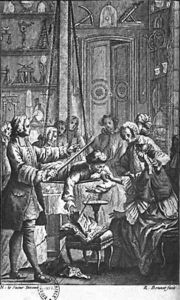Nicholas Lesueur Paintings
Nicolas Lesueur (also spelled Nicolas Le Sueur) was a French painter and engraver, born in Paris in 1691. He was known for his classical and mythological subjects, as well as religious compositions. Lesueur was the son of a valet de chambre to the Duc d'Orléans, which likely afforded him access to the art world of his time.
Lesueur began his artistic training under the tutelage of Bon Boullogne, a respected French painter of the time. He also studied under the guidance of Louis Galloche, another prominent French artist. These experiences grounded Lesueur in the academic tradition of French painting, which valued historical and mythological scenes painted in a classical style with an emphasis on linearity and clear composition.
His career progressed as he became a member of the Royal Academy of Painting and Sculpture in 1720. Lesueur also worked for the Gobelins Manufactory, which produced tapestries for the French monarchy. There, he created designs that would be woven into tapestries, many of which depicted scenes from history or mythology.
Lesueur's work was characterized by its elegance and adherence to the classical principles of art. He was influenced by the works of Raphael and the French classicist Nicolas Poussin. Despite the rise of the Rococo style during his lifetime, which emphasized more ornate and playful themes, Lesueur remained dedicated to the grandeur and seriousness of the classical tradition.
His contributions to art were not limited to painting and tapestry design; Lesueur also created illustrations for books, such as an edition of Virgil's 'Georgics' published in 1741. These illustrations further demonstrate his skill and dedication to classical subjects.
Nicolas Lesueur passed away in 1764, leaving behind a body of work that exemplifies the French classical tradition. While he may not be as well-known as some of his contemporaries, his artistry and commitment to the classical style have ensured him a place in the history of French art.
